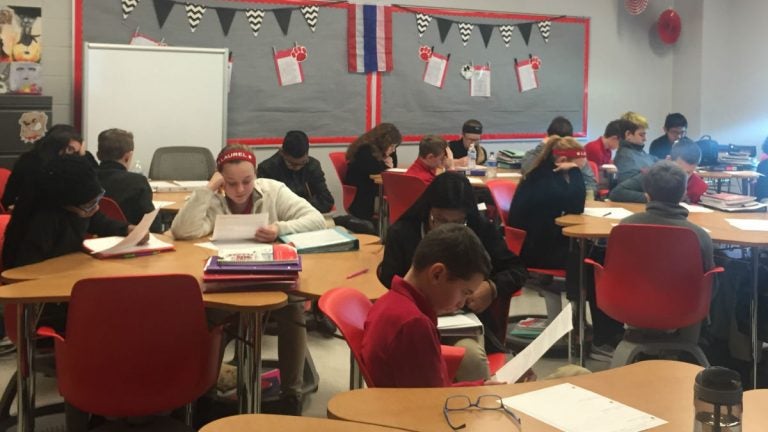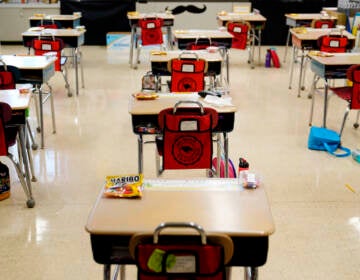Delaware school test scores mostly stagnant; SAT results drop
While scores have ebbed this year, Department of Education officials are stressing that scores in the Smarter Balanced tests have risen since they were first given in 2015.

Laurel Middle School, which was once slated for possible closure because of poor academic performance, has bucked the trend in Delaware and improved by double digits in the last two years in standardized math and English tests. (Cris Barrish/WHYY)
Delaware students continue to struggle on the state’s standardized tests, with most scores falling from 2017 to this year, results released Wednesday show.
Overall scores in math for third- through eighth-graders showed that only 44 percent are proficient, down from 45 percent in 2017.
In English language arts testing, which evaluates reading and writing, scores held steady at 54 percent for kids in grades three through eight.
While scores were relatively stagnant for elementary and middle school students, average scores regressed in the SAT test, taken mostly by high school juniors and seniors.
Only 28 percent of students were proficient in math, a drop of 1 percentage point from 2017.
On the English section of the SAT test, which is technically called “evidence-based reading and writing,” only 50 percent of kids were proficient, down from 53 percent in 2017.
Scores in the SAT essay plummeted, with only 40 percent proficient, down from 53 percent in 2017.
Delaware education officials consider proficiency in the tests to mean that students are “on the track to college and career readiness,’’ said Theresa Bennett, the state’s assessment director.
While scores have ebbed this year, Bennett and officials at the Department of Education who released the results are stressing that scores in the Smarter Balanced tests have risen since they were first given in 2015.
Math scores were up 5 percentage points over the four-year period, while English scores have risen 2 percentage points in the Smarter Balanced tests.
Education Secretary Susan Bunting was not available for an interview Wednesday. In a written statement, she conveyed optimism.
“Our educators and students worked hard to achieve these successes,” it said. “We’re seeing more schools and districts using tools provided by the state to help inform instruction and improve student learning. We will continue supporting our teachers so that we can collectively improve achievement levels across the state.”
In an interview, Bennett acknowledged that serious challenges remain in preparing the state’s 138,000 public school kids, especially those about to graduate, for the future.
“We just spent a considerable amount of time just looking at access to advanced coursework and how our students are moving through the courses in high school and how we’re setting them up for success before they even leave middle school,’’ she said.
The plummeting essay scores concern Bennett.
“We want our students to be able to analyze what they’re reading and take it to paper and be able to show what they know,’’ she said.
Atnreakn Alleyne is former state education administrator who runs the nonprofit Delaware Campaign Achievement Now, which advocates for high-quality education for all kids.
After reviewing the results and the state’s news release headlined “assessment results hold steady,” Alleyne said he’s disturbed that his former office and the administration of Gov. John Carney want to “spin the results in a way that is more political speak’’ than the way “everyday people’’ would view the lackluster performance.
“You can look at businesses that our governor and leadership for that matter are trying to attract here to bring jobs and opportunity and technology,’’ Alleyne said. “If they heard these results and heard us saying we are making steady progress year over year with 44 percent proficient in math, I also think that’s laughable.”
Bennett said the state will soon dig into this year’s numbers to work with schools and districts to develop action plans. She pointed out that, unlike regular testing at schools, the SAT is a timed test. That may be an area to address in preparing students for the test many colleges use as one measure of a student’s fitness for their school, she said.
On Wednesday night, after this story was posted, Gov. Carney’s office sent WHYY a three-paragraph statement in he stressed that Delaware’s overall scores are unacceptable.
“My most important job as Governor is ensuring that Delaware has a strong, growing, and globally competitive economy. That starts with educating our children, and giving them every opportunity to succeed in an economy that is changing every day,” Carney’s statement said. “While only one measure, the data published this week shows that while we have many bright spots across our state, too many of our students are still being left behind. It’s clear that there is more work to be done to make sure every student succeeds.”
Carney added that he and Bunting “make a make a point to spend time with educators and students in schools across our state. Many of them are achieving great things. Educators and school leaders in Seaford and Laurel are getting it right, and their students are getting the results to prove it. … The growth shown by students in both districts is no accident, and is a testament to the work they’ve done each and every day in the classroom. We must replicate their work across the state to help our students who are struggling to keep pace.’’
Carney also pointed out that his administration, which cut millions of dollars of funding from education last year amid budget trubles, also created a $1 million “Opportunity Grants program to provide additional supports for low-income students and English learners.”
His administration has also “provided incentives for teachers to work in high-needs schools and subject areas because we know what matters most is having a great teacher in the front of the classroom.”
Laurel Middle among bright spots
Despite the overall sluggish results, bright spots are evident in many districtwide gains in Smarter Balanced math.
Three were downstate: Indian River, where Bunting was superintendent until January 2017, Laurel and Seaford. Also improving were Smyrna, which straddles New Castle and Kent counties, and Christina, in New Castle County.
Among charter schools, a handful did better with math: First State Montessori; Freire; Kuumba Academy; MOT Charter; and Campus Community.
Laurel Middle School, whose dramatic progress after facing possible closure was featured on WHYY’s “First’‘ television show this year, has improved in math from 14 percent to 40 percent over two years and from 29 percent to 55 percent in English.
“First and foremost, we credit our successes to our diligent and dedicated instructors, who worked collaboratively in school data teams analyzing student performance to foster a continuous improvement model throughout our schools,” Laurel Superintendent Shawn Larrimore said.
Other districts improving over last year in Smarter Balanced English were Appoquinimink; Indian River; Lake Forest; Seaford; and Smyrna.
Charters improving in English were Academy of Dover; First State Montessori; Campus Community; East Side; Academy Antonia Alonso; Kuumba Academy; and Providence Creek Academy.
Among high schools, in SAT math these improved: Cab Calloway School of the Arts; Cape Henlopen; Christiana; Concord; Conrad Schools of Science; Delcastle; Newark; William Penn; Smyrna; Sussex Tech; Woodbridge; Delaware Academy of Public Safety and Security; Delaware Military Academy; and MOT Charter.
These high schools went up in SAT English: Appoquinimink; Cab Calloway; Cape Henlopen; Christiana; Concord; Delmar; Sussex Tech; MOT Charter; Newark Charter; and Sussex Academy.
In the SAT essay, several schools had drops of more than 20 percentage points. Brandywine, which plummeted from 46 percent to 19 percent, fell the furthest. Others with drops of 20 or more percentage points were Conrad Schools of Science; Dover; Mount Pleasant; Lake Forest; Conrad; and MOT Charter.
WHYY is your source for fact-based, in-depth journalism and information. As a nonprofit organization, we rely on financial support from readers like you. Please give today.





